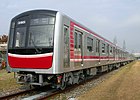Osaka Municipal Subway 70 series
This article needs additional citations for verification. (February 2024) |
You can help expand this article with text translated from the corresponding article in Japanese. (June 2023) Click [show] for important translation instructions.
|
| Osaka Municipal Subway 70 series | |
|---|---|
 Osaka Municipal Subway 70 series in revised livery at Kadoma-minami Station, March 2012 | |
| In service | 1990–present |
| Manufacturer | Kawasaki Heavy Industries, Kinki Sharyo, Nippon Sharyo, Alna Kōki |
| Constructed | 1990–1997 |
| Entered service | 20 March 1990 |
| Refurbished | 2011– |
| Number built | 100 cars (25 sets) |
| Number in service | 100 cars |
| Formation | 4 cars per trainset |
| Capacity | 380 |
| Operators | Osaka Municipal Transportation Bureau (1990–2018) Osaka Metro (2018–present) |
| Depots | Tsurumi |
| Lines served | Nagahori Tsurumi-ryokuchi Line |
| Specifications | |
| Car body construction | Aluminium |
| Train length | 62.8 m (206 ft 0 in) |
| Car length | 15.8 m (51 ft 10 in) (end cars) 15.6 m (51 ft 2 in) (intermediate cars) |
| Doors | 3 pairs of sliding doors per side |
| Maximum speed | 70 km/h (43 mph) |
| Weight | 102 t (100 long tons; 112 short tons) |
| Traction system | Variable-frequency |
| Traction motors | Linear motors |
| Power output | 800 kW (1,073 hp) |
| Acceleration | 2.5 km/(h⋅s) (1.6 mph/s) |
| Deceleration | 3.5 km/(h⋅s) (2.2 mph/s) (service) 4.5 km/(h⋅s) (2.8 mph/s) (emergency) |
| Electric system(s) | 1,500 V DC |
| Current collector(s) | Pantograph |
| Braking system(s) | Electric commanding |
| Safety system(s) | CS-ATC, ATO |
| Track gauge | 1,435 mm (4 ft 8+1⁄2 in) |
The Osaka Municipal Subway 70 series (大阪市交通局70系) is a rapid transit electric multiple unit (EMU) train type operated by Osaka Municipal Subway on the Nagahori Tsurumi-ryokuchi Line in Japan.[1]
The 70 series was among the earliest trains in Japan to use linear motors, and is capable of driverless operation.
Refurbishment[edit]
All 25 70 series trains are scheduled to undergo major refurbishment, with set 13 the first refurbished set to re-enter service on March 4, 2011.[citation needed] The refurbishment will include the fitting of new linear motor traction systems, a new 3-colour LED display system above passenger doors, new LCD passenger information monitors, lower hand grips, a yellow line printed on passenger doors and new train car number indicators on the exterior similar to those seen on the 30000 series and the refurbished 25 series trains.

